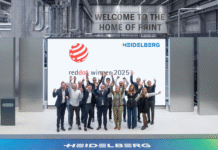A comparative study, initiated by the European Rotogravure Association (ERA) and led by Prof. Lutz Engisch from HTWK Leipzig, is shedding new light on the sustainability of rotogravure printing in an industry facing increasing environmental and regulatory pressures.
Building on an initial 2022 sustainability study, this ongoing research aims to scientifically compare various printing technologies, identifying key environmental impacts and opportunities for improvement. The study, set to conclude in 2026, will provide a comprehensive framework for sustainable decision-making in the printing industry.
Advancing sustainability in printing
Rotogravure printing has long been known for its high efficiency in large-scale production, precision, and durability. Additionally, its ability to reuse cylinders, accommodate recyclable materials, and support mono-material substrates makes it a strong contender in sustainable printing. Modern solvent recovery systems further mitigate environmental concerns, reinforcing its eco-friendly potential.
Despite these advantages, the study examines challenges such as energy-intensive cylinder production and VOC emissions from solvent-based inks. Researchers are exploring innovative solutions to reduce environmental impact and improve the overall sustainability of printing technologies.
Application-based comparisons for a targeted approach
Rather than assessing printing technologies in broad terms, this study compares them based on specific applications, ensuring a more accurate evaluation of sustainability factors, including energy use, emissions, and material waste.
The key focus areas include:
- Flexible Packaging: Rotogravure vs. flexographic printing.
- Decorative Printing: Rotogravure vs. inkjet printing.
- Packaging and Commercial Printing: Rotogravure vs. offset printing.
This application-focused approach ensures that sustainability improvements are tailored to the unique demands of each printing method.
Scientific methodology and regulatory alignment
The study follows a rigorous and structured methodology, including:
- Defining study boundaries and relevant parameters.
- Collecting data on energy consumption, waste, materials, and transportation emissions.
- Establishing Corporate Carbon Footprint (CCF) and Product Carbon Footprint (PCF) metrics.
- Conducting audits to verify results.
Additionally, the study aligns with EU sustainability regulations, including the Corporate Sustainability Reporting Directive (CSRD) and the Ecodesign for Sustainable Products Regulation (ESPR). These frameworks promote transparency, double materiality assessment, and circular economy principles, ensuring that the findings contribute to a more sustainable printing industry.
Early Insights and Industry Impact
Preliminary results indicate that rotogravure printing remains a leading choice for high-quality, high-volume production. Its material efficiency and recyclability make it particularly valuable for flexible packaging and decorative printing. However, offset and inkjet printing may present advantages in specific cases, such as shorter print runs and certain substrate requirements.
With a targeted completion in 2026, the study will provide a scientific, industry-backed framework for evaluating and enhancing sustainability in printing technologies. The ERA, in collaboration with HTWK Leipzig, is committed to ensuring that the findings support informed decision-making and continuous innovation within the sector.
As the printing industry adapts to increasing sustainability requirements and regulatory changes, this ERA-initiated research is crucial in guiding companies toward environmentally responsible choices. Rotogravure printing, with its inherent strengths in high-volume, high-quality production, continues to be a reliable and sustainable option.
This study is set to play a pivotal role in shaping the future of sustainable printing technologies, helping businesses align with eco-friendly practices while maintaining efficiency and quality.












